Power Consumption and Noise
The power supply is the same 19V unit we got with the Beelink SER8.
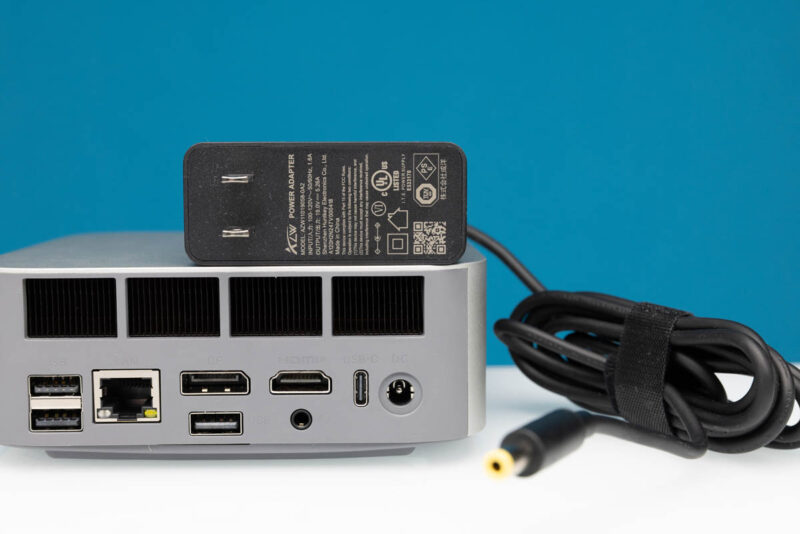
What Beelink nailed on this unit is the power consumption and noise. We were in the normal 7-9W idle for this system, but under load, we were in the 78W range at the wall. Remarkably, the system just sat at that power level. We showed about 10 minutes of load at this power level in the video, but we ran it for over 30 minutes, and it did not down-clock. Most mini PCs get a few seconds at their maximum power levels, then drop down. This just sat at its maximum performance level.
We should also note that the noise was really good. In our 34dba noise floor studio, we were getting sound meter readings at 1m at around 35dba at idle and 40dba under load. Sustained performance and low noise are a huge win. That has meant that Beelink increased the size of the chassis over systems we saw two years ago, but we are here for it if it means lower noise and sustained performance.
Key Lessons Learned
The internals are such a mixed bag. On the one hand, we have a great CPU, iGPU, and NPU, but that comes at the cost of only having 32GB, full stop. It is strange to see the iGPU reserve memory from 32GB when you also have 12 cores and 24 threads as this starts to get close to a 1GB of RAM per thread solution, which just feels like too little. That is an AMD/ Beelink thing since co-packaging more LPDDR5X memory is a hit to the margins unless you are able to charge Apple prices for RAM. If you want a server, you are probably memory capacity-constrained and probably better off with the GTi Ultra 12. Likewise, if you just want pure gaming performance and do not want the compact package, the Beelink GTi Ultra 12 with a dock and an eGPU will be the better option, albeit it is much larger.
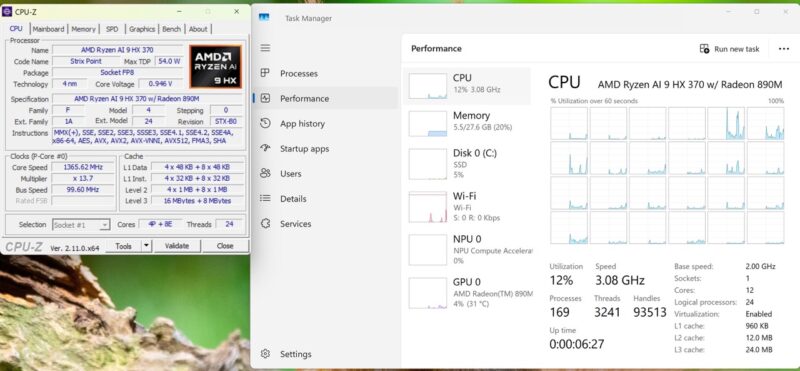
Getting inside the system, however, yields great thermal management that somehow lets this system run at high speed quietly. Still, the idea of removing six screws for the dust filter feels rough. Likewise, the little speaker unit might offer immersive sound for a grasshopper, but it feels like free economy-class airline headphones that let you hear but are far from sounding good.
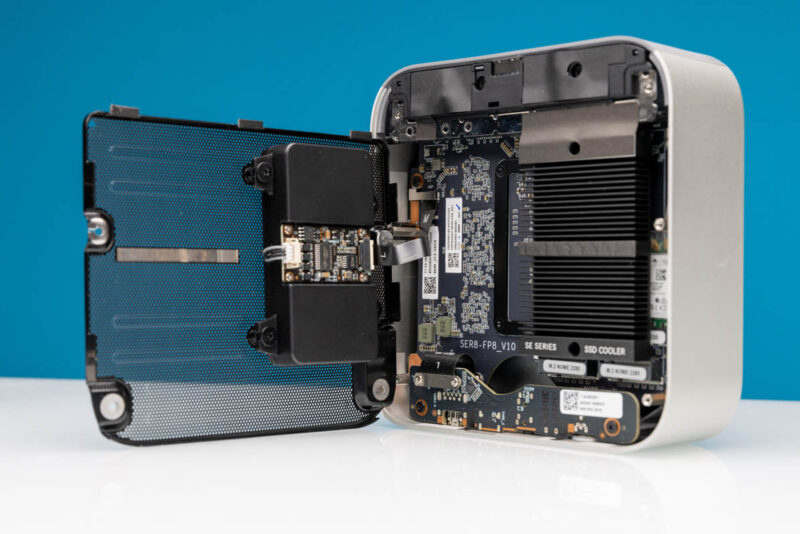
Then the specs: at $999, Windows 11 Pro feels right, but the Intel AX200 WiFi 6 feels like it should be a WiFi 6E or WiFi 7 solution, and a 1TB NVMe SSD is just too small for that price range in 2024.
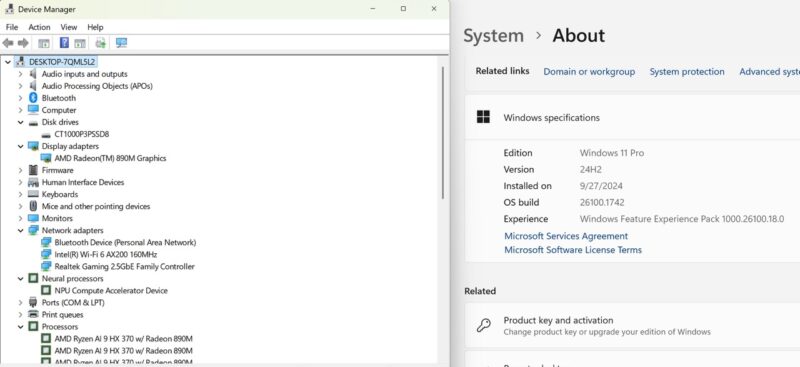
At $999, this is a great system if it is exactly what you want. However, there are still a number of folks who will see that price and jump to other options. For example, the GPU dock plus GTi Ultra 12 is $738. If you simply want a larger, higher-performance gaming system with dual NICs, an internal power supply, and the ability to add RAM and a GPU, then that is a very compelling option.
Final Words
At some point, after testing this system, it is incredible to see how much faster these have gotten. Three years ago, running e-sports titles at 4K was pretty iffy. You could do it, but you were not going to get ~120fps and decent detail. Or better said, there was playable, but it was easy to see detailed differences between this and a system with a NVIDIA GeForce GTX 1650. On the CPU side, we get 12 Zen 5(c) cores, which is a nice bump from eight previously. A 50 TOPS NPU is one of those features that is good for today’s systems, but as software developers start using the NPU more, we will, of course, want more. The bottom line, though, is that NPUs are happening across the ecosystem, so software will take advantage of it in the future.
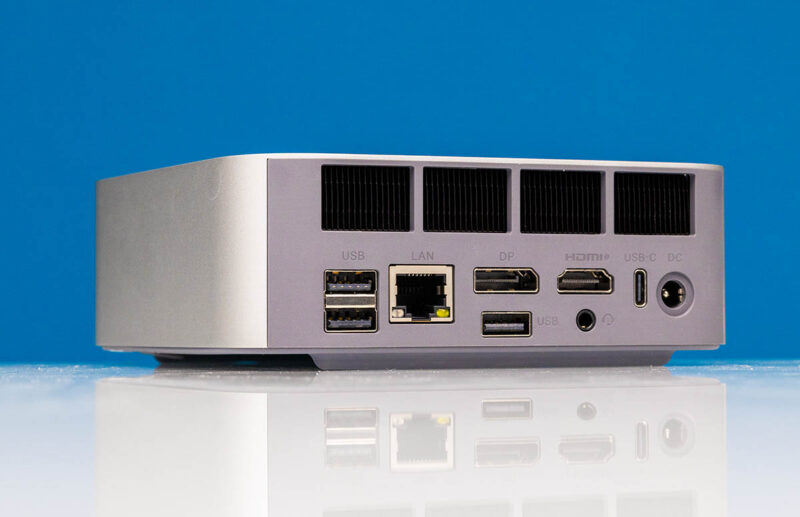
This is a cool system. It might be the fastest mini PC out there, that still fits in a mini PC form factor. It is also one of the more expensive, so perhaps it better be.
Where to Buy
Here is an Amazon link to check the latest pricing: Beelink SER9 Amazon Affiliate.




I actually like external power supplies for this type of system.
Internal power supply might fail and that’s a pain to replace, where-as an end user with one of these – I ship a new power supply they can plug in. Its not terribly proprietary either, most barrel jacks for 19v are the same one. The internal one will be proprietary enough that I won’t want to replace it, and more likely to just ship a new one.
The mic/speakers, I mean I see why, cuz everyone zoom/teams now, and this is at least possible with this box…I would rather see that as an add-on option. I’d be likely to remove that and the dust filter entirely.
For home-lab use…dual nics, dual 10g sfp+, and ram expansion…. I have thinkcenter p350’s doing that work today with dual 10g nic addons. Wish we had tiered memory on these new onboard ram cpus from AMD/Intel – give us that 32G on-package ram, but give me the option to expand it with slower memory, some simple logic like NUMA extensions but for RAM since some will be DDR5 ~5000 and some will be on-package ~8000. There is a 64GB version of this chip as well I see. The new i9 ultras have similar setup as does the new apple chip.
All in it’s nice, but other than replacing the one-off workstation with one, I don’t think I’d use it in my lab…preferring more ethernet and fewer bells/whistles like the speaker setup.
I appreciate how balanced of a review this and the video were. I’ve watched and read maybe 9 different videos and reviews on this. At least STH has the balls to say what is good (AMD APU and cooling) and what is not good (price, 32GB, speakers, WiFi, dust filter.) I’m still on the fence, but at least I can articulate WHY since it’s all here. I think you’re correct that I’m on the fence because of the price. $699 and I’d have two already.
PS it’s $899 on Amazon using the coupon there
I think you made a mistake here: “That is an AMD thing since co-packaging more LPDDR5X memory is a hit to the margins unless you are able to charge Apple prices for RAM”
AMD’s Strix Point doesn’t co-package RAM, instead it is soldered onto the mainboard. So the decision was made by BeeLink, not by AMD. The amount of RAM doesn’t influence AMD’s margins at all for this kind of device.
I would have like to see some pictures of the other side of the mainboard and the cooling solution, even though there are no RAM slots, just the soldered LPDDR5X chips. And one one hand, I understand their choice to go with LPDDR5X, as that gives the system better signal integrity and they can clock the memory higher at 7500Mhz, which can be useful for the use case they aimed for, which I think is a mini desktop where the integrated graphics may be used for games.
If they made a “server” version of this, then yes, they could remove all the speakers and microphones and give us SODIMM slots instead. Or two USB4 ports. Or a 10G NIC. Or all three. That would be pretty amazing.
MDF – Great points.
Ryan – Thanks.
Stefan – Good point. Updated with Beelink to make it clearer. I had a rough bout of food poisoning Sunday from hotel food and am still not 100%.
Robert – I totally agree.
Bought probably ~10 of SER7 and SER8 for use for technical computing so far, all for export controlled technologies. Built in microphone(s) means I won’t be buying any SER9’s
WIFI 6E/7: Intel seems to block their better WIFI cards from working on AMD systems.
I got myself a Lenovo LOQ ARP9 sporting a Rembrandt-R 7435HS APU and an RTX4060 at a very low price, so I naturally tried swapping everything not soldered down, including the very mediocre MediaTek WIFI. At €22 the Killer variant of an Intel BX200 WIFI7 was only €3 premium over my usual AX100 WIFI6 card, so I went for that and was surprised it wouldn’t even boot: not a peep or BIOS, just plain dead!
The AX100 worked just fine, though, so I went with that and then investigated a bit later. Turns out I’m not the only one, plenty of people report that Intel WIFI adapters later than the AX100 simply won’t work on AMD, any AMD laptop or desktop!
And that both AMD and Intel do not comment on that issue at all…
I believe you are in a prime position to investigate that issue and if true, shine some public attention onto something that would then have to be some rather underhanded behavior by ….Intel, I’d have to presume, very similar to the USB4 story and many other past sins.
I keep hearing that 32GB is a hard limit with LPDDR5, either with Strix Point or even generally, so once a vendor goes with the LPDDR5 route for the bandwidth the iGPU requires to deliver its top performance, that where you’ll end up.
If you go with SO-DIMMs instead, iGPU performance will suffer from the lower bandwidth, perhaps not quite the Radeon 780m level of its predecessors, but closer.
Can’t really have it both ways, I guess and I doubt you can mix soldered LPDDR5 with a single channel DDR5 SO-DIMM, which would be rather better than having only 32GB in a µ-server setup.
I run an Alder-Lake laptop which uses 8GB of soldered DDR5 and came with another 8GB as a DIMM, where I replaced the latter with a 32GB variant. Has it perform with dual channel bandwidth for the iGPU and what left of the 1st 16GB beyond the frame buffer and drops to single channel beyond, where it’s the CPU juggling VMs.
But that’s still way better than paging or having to get a different machine and I rarely notice it.
But that’s DDR5 on both sides, something the memory controller was designed to handle.
*Mixing* LPDDR5 and DDR5 on a single system most likely isn’t supported, even if the memory controller can be switched between either type.
Can this do RAID 1?